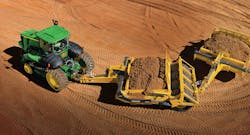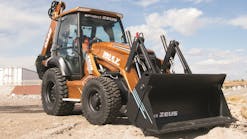Unlike a skid-steer loader, mini-excavator, or other piece of compact construction equipment, you can’t push dirt or dig a trench with a trailer. But, when it comes to making a profit in the earthmoving business, a good trailer more than pulls its weight.“If you think a trailer doesn’t make you any money, just remember, your loader or excavator can’t get to the job site without a safe, reliable way to haul it there,” says Marv Odegaard. He’s national sales manager for Trail King Industries, which builds trailers ranging in size from 16-foot, 6,000-pound capacity tandem axle units for hauling a compact track loader to a 23-axle, 200,000-pound behemoth for transporting a power plant transformer.Randy VanConett, who owns Accurate Construction and Excavation, Grand Junction, CO, appreciates the value of a trailer. In fact, he owns several trailers for hauling various types of earthmoving equipment. They include a 16-foot tandem-axle model with a 4-foot dove tail and folding ramp, made by Eager Beaver Trailers. Although payload capacity is 16,000 pounds, he says, he uses it to haul loads of about 8,000 to 10,000 pounds. Usually, this includes a skid-steer loader or compact-excavator plus various construction supplies, such as rebar or sacks of concrete.Since purchasing the trailer 13 years ago, he’s used it to haul equipment more than 100,000 miles across mountainous terrain. Although he can tow the loaded trailer with a three-quarter-ton pickup, he prefers the extra stability of pulling it with a one-ton pickup with dual rear wheels.One of VanConett’s key considerations in selecting a trailer is balance, how well it distributes the load over the length of the trailer. “If the trailer carries the load too far forward or too far to the rear,” he says, “steering and braking suffers, and it’s very hard on the truck’s and trailer’s suspension.”The trailer’s oak deck has held up very well, he reports. “The trailer is very low maintenance,” he says.His trailer is equipped with a tongue-mounted tool box for hand tools and chains and he’s added a 2-inch by 6-inch channel iron along the sides of the trailer to contain pallets or small gravel or dirt loads.VanConett has equipped his towing units with a Draw-Tite Activator III controller switch that allows him to vary the flow of electricity to the electric brakes as needed, depending on the load. “I can adjust the amps up or down to increase or decrease the braking power,” he says. “It gives me much better control of the brakes than that of a typical electrical brake controller and it allows me to match the braking power to each of the three different trucks we use to tow the trailer. This much more precise control has at least doubled the life of our brakes compared to a fixed-amp brake controller.”Jimmy Harris, Harris Construction Co., Dumfries, VA, has two trailers for transporting his construction equipment—a 12-foot flatbed Beck trailer, which he bought 15 years ago as part of a package when he bought a skid-steer loader, and his newest one, a 20-foot, 14,000-pound capacity two-axle Kaufman flatbed trailer. “The trailer is plenty big enough to haul anything I have,” he says. That includes his new tractor-loader backhoe or skid-steer loader. It will also accommodate his next planned equipment purchase, a compact track loader.He chose a steel deck for lower maintenance costs than a wood deck, and electric brakes for better control than surge brakes, he says.
PHOTO: KAUFMAN TRAILERHarris, who does a lot of research when buying equipment, shopped around before selecting his Kaufman trailer. “I wanted to get the most for my money,” he explains.When the job calls for his compact equipment—a 7,700-pound skid-steer loader and an 11,500-pound excavator—golf course renovation contractor Dan Soushek loads them both on his 22-foot, tandem axle, CZ trailer. Soushek, who owns Golf Plus, Maple, Valley, WA, uses a variety of equipment in his grading and excavating work.The trailer’s 20-ton capacity and beavertail design gives him the flexibility to transport the compact machines or other equipment, including a small dozer, a track excavator or a 5-yard dump truck. “I wanted a trailer to handle a variety of needs,” says Soushek who bought the trailer new 12 years ago. “This one is perfectly suited for what I do.”The trailer, which he tows behind a tandem-axle dump truck, features an oak deck, D-ring tie-downs, a pintle hitch, air brakes, and spring-assisted ramps for easier lifting.When hauling his compact equipment, Soushek loads the skid-steer loader first. Carrying a set of pallet forks in the attached bucket, he backs the loader up to the front of the trailer. Then, he backs his compact excavator up to the skid-steer loader, resting the excavator’s stick and bucket on the beavertail. If needed, he carries his other attachments—a trenching bucket and a grading bucket—in the back of his dump truck.The beaver tail design was an important consideration for him in buying this trailer. The main deck sits about 36 inches above the ground, while the beavertail slopes down to about 2 feet above the ground at the rear of the trailer, he reports. This helps shorten overall height when transporting his taller equipment, like his track excavator.A Growing Market
When it comes to buying a trailer to haul compact equipment, there are plenty of makes and models, not to mention standard features, options, and accessories.One industry observer estimates that more than 200 companies manufacture trailers of all sizes in the US. Some contractors buy their trailers from the dealer who sold them their skid-steer loader, mini-excavator, or other piece of compact equipment. Others shop among various trailer dealers or buy direct from the factory.PHOTO: TRIPLE LDepending on the size of the machine and the number of attachments being hauled, trailers best suited for hauling a skid-steer loader or compact excavator generally have decks that measure no longer than about 18 feet and no wider than 8 feet with payload capacities of 14,000 pounds or less.Bob Cramer, sales manager with Redi-Haul Trailers Inc., Fairmont, MN, estimates sales of such trailers have increased about 25% to 30% a year for the past decade or so. This, he says, reflects the growing demand for compact construction equipment to fit into tight work spaces in cities and shrinking residential job sites in the suburbs.”The two most popular EZ Dumper trailer models for hauling compact construction equipment are the 12-foot and 14-foot long deck units, reports Christian Baillie, national sales manager of the Waynesboro, PA, company. Either model has enough deck space to hold an appropriate-sized skid-steer loader with attached bucket.Not long ago, the 10-foot deck was the most popular size for transporting skid-steer loaders and compact excavators, Baillie notes. “The growing demand for larger compact equipment and the availability of larger pickup trucks to haul the units is driving the sales of the longer trailers,” he says. “I expect this trend to continue and we’ll probably be selling more 16-foot to 20-foot deck trailers in the next few years.”A Broad Selection
Probably the two most important decisions facing a contractor when buying a trailer are size and type of deck.“It’s probably best to buy a trailer with about 25% more payload capacity than the weight of the base machine you’ll be hauling,” Cramer says. “Then you can also carry attachments and other materials needed on the job.”Using this rule of thumb, then, a suitable trailer for a mid-size 6,000-pound skid steer loader would offer a 7,500-pound payload capacity, while a good match for a large compact excavator weighing 11,000 pounds would have a payload capacity of close to 14,000 pounds. When it comes to decks, you can choose from several different styles: tilt beds, which eliminate the need for ramps; flat beds recessed between the side frame or wheels for lower deck height, or mounted on top of the frame or above the wheels for more useable width; multi-purpose trailers that can haul and dump dirt as well as drop-off and pick-up equipment; and gooseneck trailers, favored by some contractors for their more stable towing characteristics and ability to turn tightly.Among the Many Choices
Utility and Tilt Units
Redi-Haul Trailers sells three series of models for transporting compact construction equipment. They include flatbed utility models with an 8-foot-wide, 20-foot-long deck, two 5-foot ramps, and dual 6,000-pound axles; tandem axle equipment transport trailers and tandem axle full tilt trailers available in deck lengths of 14 feet to 18 feet, with payload capacities from 10,400 pounds to 15,730 pounds; and equipment transport trailers with 12-foot to 16-foot decks and 6,000-pound to 17,260-pound payload capacities.Trail King trailer models include a utility trailer with a 12-foot-long, 95-inch overall width (76-inch-width between the fenders), has two 3,000-pound axles and two 5-foot-long self-supporting loading ramps. Loaded deck height is 18.5 inches. The company’s tilt utility trailer has a 16-foot-long and 102-inch-wide deck (82 inches between the fenders), which rides on two 6,000-pound-capacity axles. With a 20-inch loaded deck height, it offers a load angle of 11 degrees.Kaufman Trailers manufactures a variety of models for hauling compact construction equipment with deck lengths of 12 feet to 18 feet, a deck height of 21 inches and axle capacities ranging from 3,500 pounds to 7,000 pounds.No-Ramp, No-Tilt Transport
JLG Industries Inc., Hagerstown, MD, offers another alternative—the Triple-L line of trailers, which includes flatbed, utility trailers with sides; and enclosed trailers that eliminate the need for ramps or tilt beds. The entire deck lowers to the ground for drive-on loading and then raises for transport. The flatbed trailer decks, most of which operate hydraulically, range in length from 8 feet to 14 feet, with payload capacities of 2,200 pounds to 10,000 poundsMulti-Purpose Trailers
EZ Dumper trailers, equipped with standard 21-inch-high steel sides and hydraulic lift, can be used to deliver and pick up equipment and for other jobs—like hauling and dumping dirt, gravel, and other materials, or serving as mobile trash bins. The low-profile trailers feature an 80-inch-wide deck that sits between the wheels for a lower deck height. Three models are available in deck lengths of 10 feet, 12 feet, and 14 feet. A two-way tailgate opens like a barn door for loading and unloading skid-steer loaders and excavators. It can also be configured like a tailgate on a dump truck to dump and spread dirt and other materials.PHOTO: TRIPLE LA Specialty Trailer for Mini-Loaders
ProHauler Trailers, a division of Compact Power, Fort Mill, SC, makes trailers designed specifically to haul Kanga and Boxer mini-wheel and mini-track loaders. Available in 4-foot, 5-foot, or 6-foot widths, and lengths of 8 feet, 10 feet, 12 feet, and 14 feet, these trailers feature as many as seven different compartments for transporting a loader and various attachments efficiently and securely. “It’s a rolling toolbox for taking your machine and all your attachments with you to the job site,” says Lisa McCarley, marketing manager for the company.Custom-Built Trailers
In addition to their standard models, many manufacturers offer custom-built models. This is a way to tailor a trailer to meet your individual hauling needs and preferences—from deck length and type of ramp, to jack size, tie-down locations, and paint color—and to add or delete features to match your budget. Kaufman Trailers, for example, charges $200 for each 2 feet of extra deck length.Evaluating Features
Because of the wide array of models, features, and manufacturers, the price of trailers for hauling compact construction equipment can vary widely. While you can probably buy one of these trailers for under $2,000, you’ll generally pay a higher price for a higher quality product, say the experts. These higher price tags might include, for example, $3,500 or so for a trailer with a 6,000-pound payload or $5,000 or more for one that can haul a 12,000-pound payload.In comparing prices, keep in mind that standard features on one make or model of trailer, like D-rings for tying down equipment, stake pockets, rub rail or heavy-duty jack, may be optional or even absent on competitive makes similar in size and design.When deciding on how much to pay for a trailer, Odegaard suggests finding answers to three questions: What’s the purchase price? What will it cost to maintain? What is its resale value?“A quality-conscious buyer will consider all three questions because the answers represent the total cost of the trailer, he says.Features and Components to Consider When Shopping for a Trailer
Construction
Because they venture off the road, trailers used for hauling construction equipment are subject to more wear and tear than over-the-road trailers, notes Cramer. “Towing trailers through ditches, and over curbs and other obstacles increases the stresses put on the frame, suspension, and tires of these trailers,” he says. “Building these trailers so they are more rugged, will reduce maintenance costs and increase the service life of the trailers.”The choice of frame components, such as C-channels, I beams, or tubes, and the type of steel used to build them, such as mild steel or high-tensile steel, will affect the strength and durability of a trailer. So will spacing of the cross members. For example, cross members spaced on 12-inch or 16-inch centers produce a stronger, longer-lasting frame than those spaced on 24-inch or 48-inch centers.The type of material used to build the decking also affects durability and maintenance costs. Wood decks, typically 1.375 inches thick to 1.5 inches thick, are available in pressure-treated pine or more rugged materials, such as oak or apitong (an even longer-lasting wood). Although steel decks provide less traction, some contractors prefer their increased durability over wood decks.Axles
Manufacturers of higher quality trailers will use name-brand axles, like Dana, Dexter, or Rockwell. Low-cost trailers may have axles designed for mobile-home use.Brakes
Most trailers used to haul compact equipment have drum brakes, usually actuated by an electromagnet rather than a hydraulic system. Electric brakes provide more consistent braking action than surge brakes, which are prohibited in many statesHitch
Some manufactures offer ball-couplers that can be adjusted up and down to better match the height of the towing vehicle. Pintle hitches also adjust up or down to fit the height of different towing units.Fenders
Enclosed fenders will help keep mud and debris off the deck and the equipment. Also, a walk-on fender with a steel tread plate can make entry and exit from equipment easier.Wiring
The better wiring systems are made with sealed beam, rubber-mounted lights and soldered and jacketed wiring harnesses with no butt connectors. Other desirable features include LED turn and tail lights and 10-gauge or 12-gauge-wire enclosed in plastic conduits and protected with rubber grommets to prevent chafing where routed through frame members.Ramps
Heavy-duty ramps with feet will help stabilize the trailer and prevent the rear wheels of the pickup truck from lifting off the ground when loading and unloading machines. A spring-assisted ramp can make raising the ramp a one-handed job.At least one manufacturer offers a ramp that stores in a compartment at the rear of the bed for easy access. The ramp slides out and over into an attachment slot.Load Security
Depending on equipment being hauled, the location of tie-down rings can be important in reducing the time and effort required to secure the load. A rub rail along the side of the trailer deck provides an infinite number of tie-down points as well as impact protection for the frame.Jack
A hydraulic jack can turn the job of raising and lowering a loaded trailer into a push-button operation.Safety
A headboard, safety chains, and a breakaway switch—that automatically applies the brakes if the trailer becomes disconnected—add to safe operation.Paint
Better finishes include the use of sandblasting or chemical treatment to prepare the metal prior to painting, as well as polyurethane paint or a powder coat finish.Warranty
Warranties can range from six to 12 months for components to as long as five years for the main frame, depending on the manufacturer. Odegaard also suggests checking to see if the trailer is covered by a manufacturer’s product liability insurance. “That insurance protects you from damages due to defects in the trailer in the event of an accident,” he says.
When it comes to buying a trailer to haul compact equipment, there are plenty of makes and models, not to mention standard features, options, and accessories.One industry observer estimates that more than 200 companies manufacture trailers of all sizes in the US. Some contractors buy their trailers from the dealer who sold them their skid-steer loader, mini-excavator, or other piece of compact equipment. Others shop among various trailer dealers or buy direct from the factory.PHOTO: TRIPLE LDepending on the size of the machine and the number of attachments being hauled, trailers best suited for hauling a skid-steer loader or compact excavator generally have decks that measure no longer than about 18 feet and no wider than 8 feet with payload capacities of 14,000 pounds or less.Bob Cramer, sales manager with Redi-Haul Trailers Inc., Fairmont, MN, estimates sales of such trailers have increased about 25% to 30% a year for the past decade or so. This, he says, reflects the growing demand for compact construction equipment to fit into tight work spaces in cities and shrinking residential job sites in the suburbs.”The two most popular EZ Dumper trailer models for hauling compact construction equipment are the 12-foot and 14-foot long deck units, reports Christian Baillie, national sales manager of the Waynesboro, PA, company. Either model has enough deck space to hold an appropriate-sized skid-steer loader with attached bucket.Not long ago, the 10-foot deck was the most popular size for transporting skid-steer loaders and compact excavators, Baillie notes. “The growing demand for larger compact equipment and the availability of larger pickup trucks to haul the units is driving the sales of the longer trailers,” he says. “I expect this trend to continue and we’ll probably be selling more 16-foot to 20-foot deck trailers in the next few years.”A Broad Selection
Probably the two most important decisions facing a contractor when buying a trailer are size and type of deck.“It’s probably best to buy a trailer with about 25% more payload capacity than the weight of the base machine you’ll be hauling,” Cramer says. “Then you can also carry attachments and other materials needed on the job.”Using this rule of thumb, then, a suitable trailer for a mid-size 6,000-pound skid steer loader would offer a 7,500-pound payload capacity, while a good match for a large compact excavator weighing 11,000 pounds would have a payload capacity of close to 14,000 pounds. When it comes to decks, you can choose from several different styles: tilt beds, which eliminate the need for ramps; flat beds recessed between the side frame or wheels for lower deck height, or mounted on top of the frame or above the wheels for more useable width; multi-purpose trailers that can haul and dump dirt as well as drop-off and pick-up equipment; and gooseneck trailers, favored by some contractors for their more stable towing characteristics and ability to turn tightly.Among the Many Choices
Utility and Tilt Units
Redi-Haul Trailers sells three series of models for transporting compact construction equipment. They include flatbed utility models with an 8-foot-wide, 20-foot-long deck, two 5-foot ramps, and dual 6,000-pound axles; tandem axle equipment transport trailers and tandem axle full tilt trailers available in deck lengths of 14 feet to 18 feet, with payload capacities from 10,400 pounds to 15,730 pounds; and equipment transport trailers with 12-foot to 16-foot decks and 6,000-pound to 17,260-pound payload capacities.Trail King trailer models include a utility trailer with a 12-foot-long, 95-inch overall width (76-inch-width between the fenders), has two 3,000-pound axles and two 5-foot-long self-supporting loading ramps. Loaded deck height is 18.5 inches. The company’s tilt utility trailer has a 16-foot-long and 102-inch-wide deck (82 inches between the fenders), which rides on two 6,000-pound-capacity axles. With a 20-inch loaded deck height, it offers a load angle of 11 degrees.Kaufman Trailers manufactures a variety of models for hauling compact construction equipment with deck lengths of 12 feet to 18 feet, a deck height of 21 inches and axle capacities ranging from 3,500 pounds to 7,000 pounds.No-Ramp, No-Tilt Transport
JLG Industries Inc., Hagerstown, MD, offers another alternative—the Triple-L line of trailers, which includes flatbed, utility trailers with sides; and enclosed trailers that eliminate the need for ramps or tilt beds. The entire deck lowers to the ground for drive-on loading and then raises for transport. The flatbed trailer decks, most of which operate hydraulically, range in length from 8 feet to 14 feet, with payload capacities of 2,200 pounds to 10,000 poundsMulti-Purpose Trailers
EZ Dumper trailers, equipped with standard 21-inch-high steel sides and hydraulic lift, can be used to deliver and pick up equipment and for other jobs—like hauling and dumping dirt, gravel, and other materials, or serving as mobile trash bins. The low-profile trailers feature an 80-inch-wide deck that sits between the wheels for a lower deck height. Three models are available in deck lengths of 10 feet, 12 feet, and 14 feet. A two-way tailgate opens like a barn door for loading and unloading skid-steer loaders and excavators. It can also be configured like a tailgate on a dump truck to dump and spread dirt and other materials.PHOTO: TRIPLE LA Specialty Trailer for Mini-Loaders
ProHauler Trailers, a division of Compact Power, Fort Mill, SC, makes trailers designed specifically to haul Kanga and Boxer mini-wheel and mini-track loaders. Available in 4-foot, 5-foot, or 6-foot widths, and lengths of 8 feet, 10 feet, 12 feet, and 14 feet, these trailers feature as many as seven different compartments for transporting a loader and various attachments efficiently and securely. “It’s a rolling toolbox for taking your machine and all your attachments with you to the job site,” says Lisa McCarley, marketing manager for the company.Custom-Built Trailers
In addition to their standard models, many manufacturers offer custom-built models. This is a way to tailor a trailer to meet your individual hauling needs and preferences—from deck length and type of ramp, to jack size, tie-down locations, and paint color—and to add or delete features to match your budget. Kaufman Trailers, for example, charges $200 for each 2 feet of extra deck length.Evaluating Features
Because of the wide array of models, features, and manufacturers, the price of trailers for hauling compact construction equipment can vary widely. While you can probably buy one of these trailers for under $2,000, you’ll generally pay a higher price for a higher quality product, say the experts. These higher price tags might include, for example, $3,500 or so for a trailer with a 6,000-pound payload or $5,000 or more for one that can haul a 12,000-pound payload.In comparing prices, keep in mind that standard features on one make or model of trailer, like D-rings for tying down equipment, stake pockets, rub rail or heavy-duty jack, may be optional or even absent on competitive makes similar in size and design.When deciding on how much to pay for a trailer, Odegaard suggests finding answers to three questions: What’s the purchase price? What will it cost to maintain? What is its resale value?“A quality-conscious buyer will consider all three questions because the answers represent the total cost of the trailer, he says.Features and Components to Consider When Shopping for a Trailer
Construction
Because they venture off the road, trailers used for hauling construction equipment are subject to more wear and tear than over-the-road trailers, notes Cramer. “Towing trailers through ditches, and over curbs and other obstacles increases the stresses put on the frame, suspension, and tires of these trailers,” he says. “Building these trailers so they are more rugged, will reduce maintenance costs and increase the service life of the trailers.”The choice of frame components, such as C-channels, I beams, or tubes, and the type of steel used to build them, such as mild steel or high-tensile steel, will affect the strength and durability of a trailer. So will spacing of the cross members. For example, cross members spaced on 12-inch or 16-inch centers produce a stronger, longer-lasting frame than those spaced on 24-inch or 48-inch centers.The type of material used to build the decking also affects durability and maintenance costs. Wood decks, typically 1.375 inches thick to 1.5 inches thick, are available in pressure-treated pine or more rugged materials, such as oak or apitong (an even longer-lasting wood). Although steel decks provide less traction, some contractors prefer their increased durability over wood decks.Axles
Manufacturers of higher quality trailers will use name-brand axles, like Dana, Dexter, or Rockwell. Low-cost trailers may have axles designed for mobile-home use.Brakes
Most trailers used to haul compact equipment have drum brakes, usually actuated by an electromagnet rather than a hydraulic system. Electric brakes provide more consistent braking action than surge brakes, which are prohibited in many statesHitch
Some manufactures offer ball-couplers that can be adjusted up and down to better match the height of the towing vehicle. Pintle hitches also adjust up or down to fit the height of different towing units.Fenders
Enclosed fenders will help keep mud and debris off the deck and the equipment. Also, a walk-on fender with a steel tread plate can make entry and exit from equipment easier.Wiring
The better wiring systems are made with sealed beam, rubber-mounted lights and soldered and jacketed wiring harnesses with no butt connectors. Other desirable features include LED turn and tail lights and 10-gauge or 12-gauge-wire enclosed in plastic conduits and protected with rubber grommets to prevent chafing where routed through frame members.Ramps
Heavy-duty ramps with feet will help stabilize the trailer and prevent the rear wheels of the pickup truck from lifting off the ground when loading and unloading machines. A spring-assisted ramp can make raising the ramp a one-handed job.At least one manufacturer offers a ramp that stores in a compartment at the rear of the bed for easy access. The ramp slides out and over into an attachment slot.Load Security
Depending on equipment being hauled, the location of tie-down rings can be important in reducing the time and effort required to secure the load. A rub rail along the side of the trailer deck provides an infinite number of tie-down points as well as impact protection for the frame.Jack
A hydraulic jack can turn the job of raising and lowering a loaded trailer into a push-button operation.Safety
A headboard, safety chains, and a breakaway switch—that automatically applies the brakes if the trailer becomes disconnected—add to safe operation.Paint
Better finishes include the use of sandblasting or chemical treatment to prepare the metal prior to painting, as well as polyurethane paint or a powder coat finish.Warranty
Warranties can range from six to 12 months for components to as long as five years for the main frame, depending on the manufacturer. Odegaard also suggests checking to see if the trailer is covered by a manufacturer’s product liability insurance. “That insurance protects you from damages due to defects in the trailer in the event of an accident,” he says.







